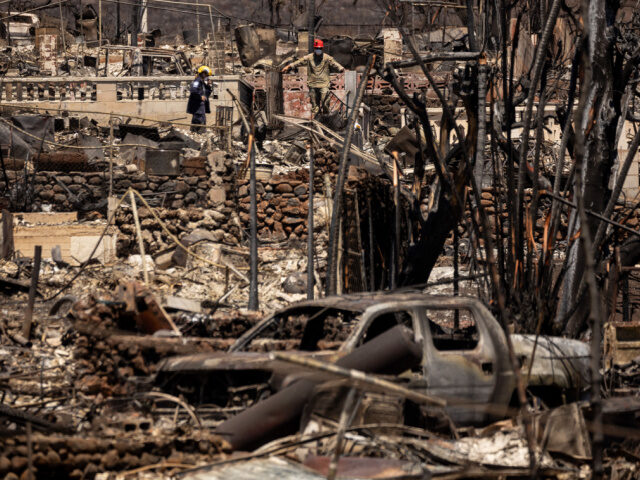The Chinese Communist Party’s state television network CGTN published a video on Friday blaming “colonialism” for the ongoing devastation in Maui, Hawaii, where wildfires are believed to have left hundreds dead and devastated the historic town of Lahaina in August.
CGTN Opinion Editor Huang Jiyuan claimed the American government’s lack of a comprehensive disaster plan and centuries of agricultural development in Hawaii left Maui residents vulnerable. While narrating the video, Huang did not use the word “colonialism” himself, but the word repeatedly appeared on screen as he asked “why” the fire became such a catastrophic event.
Maui is facing the near-total loss of the community of Lahaina and recovery efforts continue to save the dead. Local resident Dale Hermo-Fernandez told Breitbart News in a report on Thursday that local authorities have found over 450 bodies, many of them expected to be children staying home alone when the fires began.
“I guarantee you right now, from what has been seen, the number is over 450 and it’s gonna get — it’s gonna get closer to 1,000,” Hermo-Fernandez predicted.
Investigations to find the source of the fire and assess the response remain ongoing at press time.
HEARTBREAKING: Officials Conduct Grim Work of Searching Waters Off Maui for Victims of Wildfires
Hawaii DLNR / LOCAL NEWS X /TMXThe Chinese government has used other state media outlets, most prominently the propaganda newspaper Global Times, to attack America as an example of “the incompetence of the U.S. government,” which it branded as “sluggish and indifferent” compared to communist China.
The coverage of Hawaii has served to distract the government’s Chinese audience from a nearly month-long natural disaster in Hebei province, China. In early August, Typhoon Doksuri forced over a million people to evacuate and – thanks to the government diverting floodwaters to protect communist elites in Beijing and the largely uninhabited pet project Xiong’an – devastated the city of Zhuozhou, about 50 miles from Beijing.
“Wildfires were once rare on the Hawaiian islands but in recent decades they’ve become more common and extreme,” Huang narrated in the CGTN video.
“Why?” he asked, as the word “colonialism” appeared on screen.
Using historic footage of agriculture in Hawaii, Huang goes on to blame “the vast expanses of non-native grasslands” and “global warming” – which climate scientists see China as leading the world in exacerbating with its unmatched carbon emissions – for turning the islands “into a giant tinderbox.”
“In today’s era of global warming, the flammability of the shrubs means once a fire is ignited, it can spread more easily,” Huang claimed. “To make matters worse, the grasses were not the only colonial landscape changes,” he continued, referring to mounting disputes on Maui over the use of water.
The CGTN commentary followed disparaging coverage in the Global Times, China’s most belligerent state-run English-language newspaper, this month describing America as “unlike a developed country” and calling the fire a “man-made calamity.”
FEMA: ‘We Still Expect Several More Days’ to Finish Maui Search
“In China, the military, police and other professional rescue forces will respond immediately to rescue people every time when disasters occur in any location in China,” the Global Times claimed. “US sluggish and indifferent response to its domestic catastrophic incidents sharply contrasts with its fervent resource mobilization in ‘competition’ with other nations.”
In reality, as the Global Times strove to tout the alleged superiority of Chinese emergency response, outrage erupted throughout eastern China as citizens struggled to handle the aftermath of Typhoon Doksuri and of the Communist Party choosing to redirect waters toward densely populated areas to protect the homes of the regime’s elite in Beijing. By August 4, reports estimated that over one million people were forced to evacuate their homes in Beijing and neighboring Hebei province. Genocidal communist dictator Xi Jinping disappeared from the public eye while the storm swept away entire communities and clashes begun to erupt in Hebei between locals and low-ranking Communist officials suspected of attempting to break down embankments and seawalls to flood middle-class and poor communities. The local vigilante groups organized after Hebei’s top communist, Ni Yuefeng, told residents their homes must “resolutely play a good role of moat for the capital.
网友投稿
8月2日凌晨,茨村大桥西堤,政府派人偷挖大堤被村民发现并制止,现场村民与警察对峙7分钟完整版。
现场村民质疑主要有4点:
1,明明有泄洪区为什么要挖我们村的堤
2,既然没有红头文件,这些人私挖大堤是不是犯罪
3,村里还有老人小孩,如果我们没在这守堤,现在村子已经没了… pic.twitter.com/DYIStq6dK2— 李老师不是你老师 (@whyyoutouzhele) August 2, 2023
“Video clips of scuffles, lengthy altercations and clashes with police have emerged on social media in recent days,” Radio Free Asia (RFA) reported at the time, “showing embattled rural residents facing off with officials who want to flood their homes and farmland to protect Beijing, as well as ruling Chinese Communist Party leader Xi Jinping’s pet project — Xiong’an New Area.”
The Xiong’an New Area is a planned, but not yet constructed, city with little to no population. Beijing chose to protect it over areas in which regular Chinese citizens reside.
Disaster response is one of a long list of grievances that have fueled growing numbers of protests in China. According to the human rights organization Freedom House, China has experienced a marked increase in dissident activity against the Communist Party since last year, when protests erupted nationwide in late November against the Party’s repressive “zero-Covid” measures. In Freedom House’s most recent report published last week, the organization documented nearly 3,000 protests in China between June 2022 and June 2023, attracting “at least 30,000 people.”
Follow Frances Martel on Facebook and Twitter.

COMMENTS
Please let us know if you're having issues with commenting.